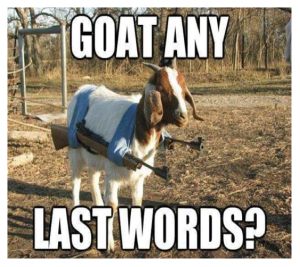Guest Blogger Steff Milovic ’19
 When you hear some cliché pun, do you laugh? Do you groan? When you’re online, do you roll your eyes and rant about how pointless that hashtag pun was?
When you hear some cliché pun, do you laugh? Do you groan? When you’re online, do you roll your eyes and rant about how pointless that hashtag pun was?
No matter what your reaction is (as listed above), you are still reacting to the pun. It originally claimed your attention and now keeps it. Your emotional reaction (whether positive or negative) encourages you to pay more attention and read into the post itself. Therefore, whether or not you are a fan of puns themselves, that little punny post has officially gotten your attention – and has therefore succeeded in its original purpose.
That aside, what exactly is a pun, and why is it so influential?
The pun is not a necessary addition to any writing, but it creates a “…play on words in which a humourous effect is produced” (http://literarydevices.net/pun/). As humor leads to an instinctual emotional reaction (ex: a laugh), the reader is likely to become more invested in the piece. It appeals greater to the reader as the emotion produced relays a feeling of connection between the reader and the writing. Other reasons to include puns in your online writing include, but are not limited to, “addressing uncomfortable or confrontational subjects, releasing tension, […] keeping the reader or audience engaged, […] providing punctuation and flow, making your work memorable, and providing cohesiveness.” Each of these reasons above continually reinforce the idea that puns draw the attention of the reader to the post, to the writing, and to the content itself.
 For all of the reasons listed above, the incorporation of puns in the material for the CUPID blog is “im-pun-tant.” It is a way for us to draw newfound attention to the blog…but how? Most puns are utilized throughout a written piece. Since many students don’t even click on the CUPID blog; however, how would these puns have any influence whatsoever on whether or not potential readers will even check out the blog?
For all of the reasons listed above, the incorporation of puns in the material for the CUPID blog is “im-pun-tant.” It is a way for us to draw newfound attention to the blog…but how? Most puns are utilized throughout a written piece. Since many students don’t even click on the CUPID blog; however, how would these puns have any influence whatsoever on whether or not potential readers will even check out the blog?
This is where social media makes its appearance. As a form of advertising, social media proves to be “…an effective way to connect with your audience and humanize your brand or company.” It is a quick way to reach out to massive audience, especially the younger population. In the case of the Scroll newsletter social media plan my class and I developed, the main readers would be distinguished as current Elon University students (thus falling under the “younger population” audience). Furthermore, the creation and implementation of puns in social media posts provides potential readers with an “…emotional appeal [that] differentiates you from the millions of other companies out there bombarding their social channels with nothing but self-promotion.” By utilizing puns in social media posts (easily done in photo captions, statuses, or hashtags), you can clearly set yourself apart from the competition. You are no longer just advertising yourself and your products…You are providing a good laugh and humor to the public.
 Just as everyone likes the funny guy at the party, everyone enjoys a good laugh from a social media post (or anything else that you’re reading). With all this in mind, it may be a good idea to start working up your own list of punny puns. To gain some “ins-pun-ration,” be sure check out some of the ones below we developed for the new English Department newsletter, The Scroll, launching this summer!
Just as everyone likes the funny guy at the party, everyone enjoys a good laugh from a social media post (or anything else that you’re reading). With all this in mind, it may be a good idea to start working up your own list of punny puns. To gain some “ins-pun-ration,” be sure check out some of the ones below we developed for the new English Department newsletter, The Scroll, launching this summer!
#ScrollinginStyle
#StopDropandScroll
#ScrollingThroughLife
#RockandScroll
#LetsScroll
#HowWeScroll
#ScrollCall
#HowtheGrinchScrollChristmas

 Follow
Follow